AWM41 969 - [Nurses Narratives] Sister G Douglas - Part 2
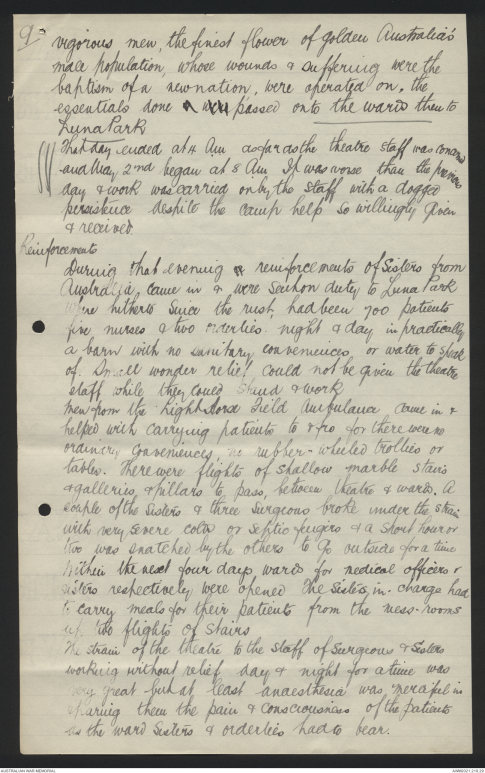
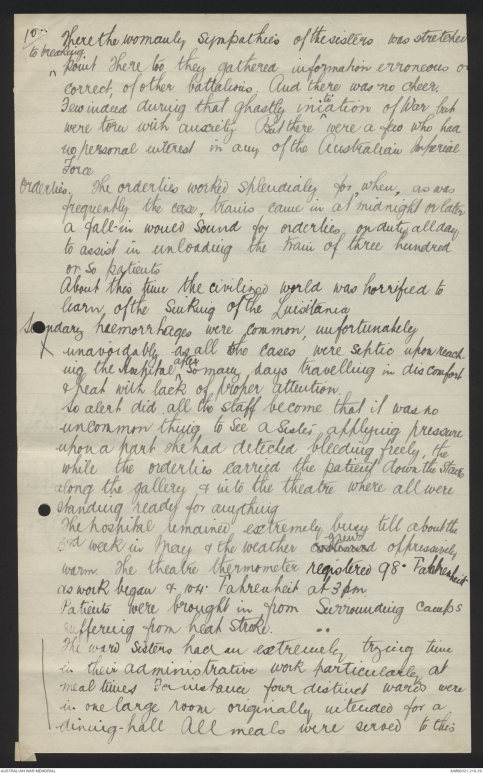
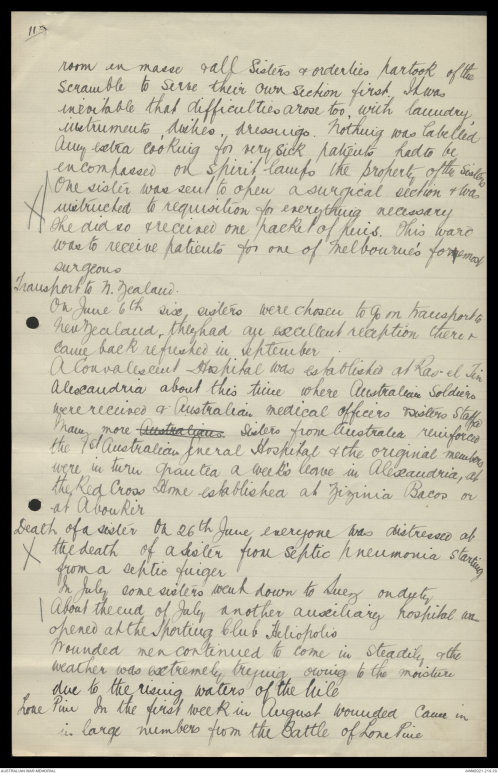
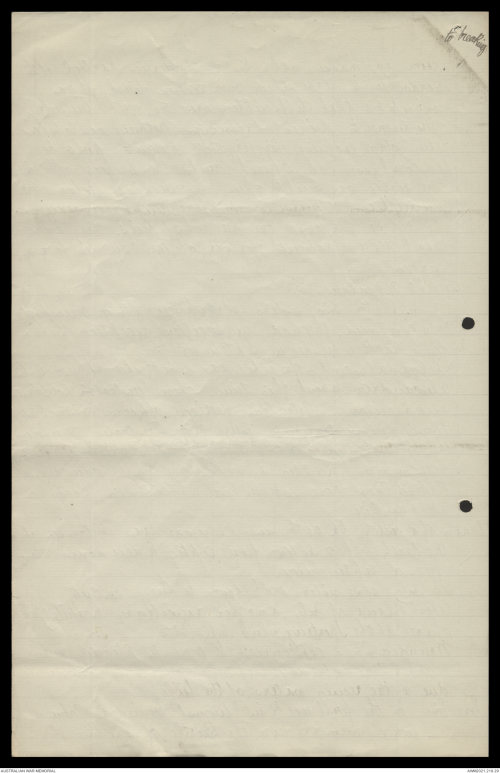
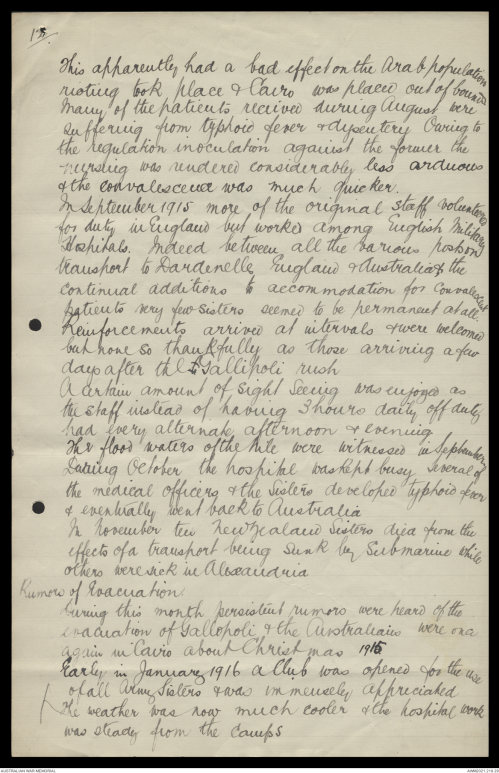
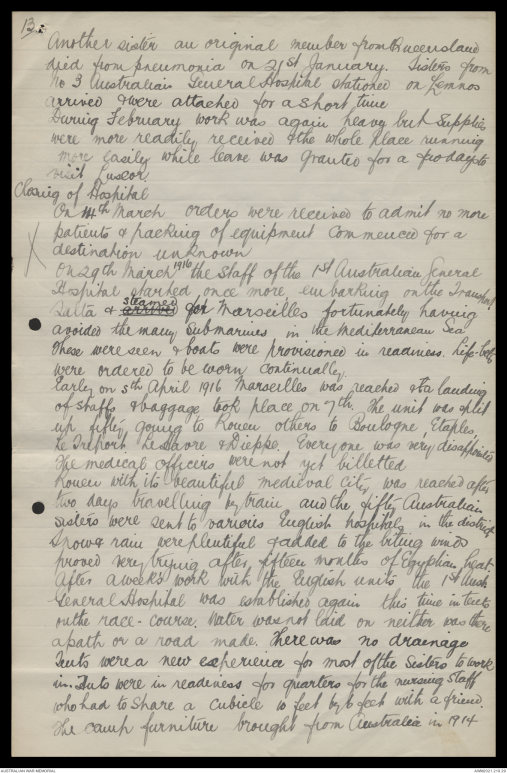
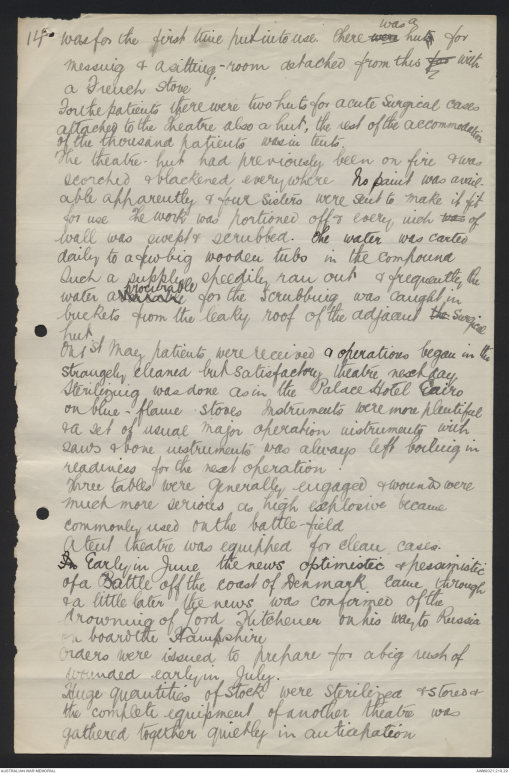
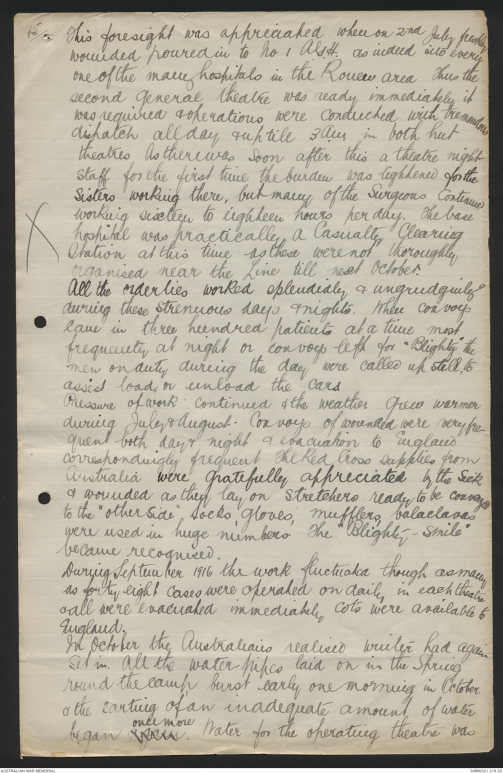
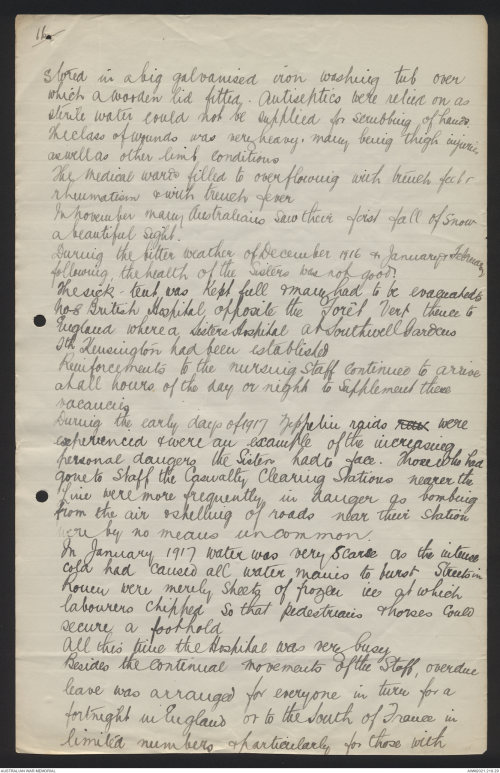

9
vigorous men, the finest flower of Golden Australia’s
male population, whose wounds & suffering were the
baptism of a new nation, were operated on, the
essentials done & were passed onto the ward then to
Luna Park.
That day ended at 4 A.M. as far as the theatre staff was concerned
and May 2nd began at 8 A.M. It was worse than the previous
day & work was carried on by the staff with a dogged
persistence despite the camp help so willingly given
& received.
Reinforcements
During that evening a reinforcements of Sisters from
Australia came in & were sent on duty to Luna Park
where hitherto since the rush, had been 700 patients
five nurses & two orderlies night & day in practically
a barn with no sanitary conveniences or water to speak
of. Small wonder relief could not be given the theatre
staff while they could stand & work.
Men from the Light Horse Field Ambulance came in &
helped with carrying patients to & fro for there were no
ordinary conveniences, no rubber-wheeled trollies or
tables. There were flights of shallow marble stairs
& galleries & pillars to pass, between theatre & wards. A
couple of the sisters & three surgeons broke under the strain
with very severe colds or septic fingers & a short hour or
two was snatched by the others to go outside for a time
Within the next four days, wards for medical officers &
sisters respectively were opened The Sisters in-charge had
to carry meals for their patients from the mess-rooms
up two flights of stairs.
The strain of the theatre to the staff of surgeons & sisters
working without relief day & night for a time was
very great but at least anaesthesia was merciful in
sparing them the pain & consciousness of the patients
as the ward sisters & orderlies had to bear.
10
There the womanly sympathies of the sisters was stretched
to breaking point There too they gathered information erroneous or
correct, of other battalions. And there was no cheer.
Few indeed during that ghastly initiation of War but
were torn with anxiety But there were a few who had
no personal interest in any of the Australian Imperial
Force.
Orderlies. The orderlies worked splendidly for, when, as was
frequently the case, trains came in at midnight or later
A fall-in would sound for orderlies on duty all day
to assist in unloading the train of three hundred
or so patients.
About this time the civilized world was horrified to
learn of the Sinking of the Luisitania
[[Seco]]ndary haemorrhages were common, unfortunately
unavoidably as all the cases were septic upon reaching
the Hospital after so many days travelling in discomfort
& heat with lack of proper attention.
So alert did all the staff become that it was no
uncommon thing to see a Sister applying pressure
upon a part she had detected bleeding freely, the
while the orderlies carried the patient down the stairs
along the gallery & into the theatre where all were
standing ready for anything
The hospital remained extremely busy till about the
3rd week in May & the weather continued grew oppressively
warm The theatre thermometer registered 98o Fahrenheit
as work began & 104o Fahrenheit at 3 p.m.
Patients were brought in from Surrounding camps
suffering from heat stroke.
The ward sisters had an extremely trying time
in their administrative work particularly at
meal times For instance four distinct wards were
in one large room originally intended for a
dining-hall All meals were served to this
11
room en masse & all Sisters & orderlies partook of the
scramble to serve their own section first. It was
inevitable that difficulties arose too, with laundry,
instruments, dishes, dressings. Nothing was labelled
Any extra cooking for very sick patients had to be
encompassed on spirit lamps the property of the Sisters.
One sister was sent to open a surgical section & was
instructed to requisition for everything necessary
She did so & received one packet of pins. This ward
was to receive patients for one of Melbourne's foremost
surgeons
Transport to N. Zealand.
On June 6th six sisters were chosen to go on transports to
New Zealand, they had an excellent reception there &
came back refreshed in September.
A Convalescent Hospital was established at Ras-el-Tin
Alexandria about this time where Australian Soldiers
were received & Australian Medical Officers & Sisters Staffed
Many more Australians Sisters from Australia reinforced
the 1st Australian General Hospital & the original members
were in turn granted a weeks leave in Alexandria, at
the Red Cross Home established at Zizinia Bacos or
at Aboukir.
Death of a sister On 26th June everyone was distressed at
the death of a Sister from septic pneumonia starting
from a septic finger
In July some sisters went down to Suez on duty
About the end of July another auxiliary hospital was
opened at the Sporting Club Heliopolis
Wounded men continued to come in steadily, & the
weather was extremely trying owing to the moisture
due to the rising waters of the Nile
Lone Pine In the first week in August wounded came in
in large numbers from the Battle of Lone Pine
[*to breaking*]
[[1?]]
This apparently had a bad effect on the Arab population
rioting took place & Cairo was placed out of bounds.
Many of the patients received during August were
suffering from typhoid fever & dysentery Owing to
the regulation inoculation against the former the
nursing was rendered considerably less arduous
& the convalescence was much quicker.
In September 1915 more of the original staff volunteered
for duty in England but worked among English Military
Hospitals. Indeed between all the various post on
transport to Dardenelles England & Australia, & the
continual additions to accommodation for convalescent
patients very few sisters seemed to be permanent at all.
Reinforcements arrived at intervals & were welcomed
but none so thankfully as those arriving a few
days after the Gallipoli rush.
A certain amount of sight seeing was enjoyed as
the staff instead of having 3 hours daily off duty
had every alternate afternoon & evening.
The flood waters of the Nile were witnessed in September.
During October the hospital was kept busy Several of
the medical officers & the Sisters developed typhoid fever
& eventually went back to Australia.
In November ten New Zealand Sisters died from the
effects of a transport being sunk by Submarine while
others were sick in Alexandria
Rumors of Evacuation.
During this month persistent rumors were heard of the
evacuation of Gallipoli & the Australians were once
again in Cairo about Christmas 1915.
Early January 1916 a Club was opened for the use
of all Army Sisters & was immensely appreciated
The weather was now much cooler & the hospital work
was steady from the camps
13
Another sister an original member from Queensland
died from pneumonia on 21st January. Sisters from
No 3 Australian General Hospital stationed on Lemnos
arrived & were attached for a short time
During February work was again heavy but supplies
were more readily received & the whole place running
more easily while leave was granted for a few days to
visit Luxor.
Closing of Hospital
On 14th March orders were received to admit no more
patients & packing of equipment commenced for a
destination unknown.
On 29th March 1916 the Staff of the 1st Australian General
Hospital started once more embarking on the Transport
Salta & arrived steamed for Marseilles fortunately having
avoided the many submarines in the Mediterranean Sea
These were seen & boats were provisioned in readiness Life-belts
were ordered to be worn continually.
Early on 5th April 1916 Marseilles was reached & la landing
of staff & baggage took place on 7th. The unit was split
up fifty going to Rouen others to Boulogne, Etaples,
Le Treport LeHavre & Dieppe. Everyone was very disappointed
The medical officers were not yet billetted
Rouen with its beautiful medieval city was reached after
two days travelling by train and the fifty Australian
sisters were sent to various English hospitals in the district.
Snow & rain were plentiful & added to the biting wind
proved very trying after fifteen months of Egyptian heat.
After a week's work with the English units the 1st Aust.
General Hospital was established again this time in tents
on the race-course. Water was not laid on neither was there
a path or a road made. There was no drainage
Tents were a new experience for most of the Sisters to work
in. Huts were in readiness for quarters for the nursing staff
who had to share a cubicle 10 feet by 6 feet with a friend.
The camp furniture brought from Australia in 1914
14
was for the first time put into use. There were was a huts for
messing & a sitting-room detached from this for with
a French stove.
For the patients there were two huts for acute Surgical cases
attached to the theatre also a hut, the rest of the accommodation
of the thousand patients was in tents.
The theatre-hut had previously been on fire & was
scorched & blackened everywhere No paint was available
apparently & four sisters were sent to make it fit
for use The work was portioned off & every inch was of
wall was swept & scrubbed. The water was carted
daily to a few big wooden tubs in the compound
Such a supply speedily ran out & frequently the
water available procurable for the scrubbing was caught in
buckets from the leaky roof of the adjacent the surgical
hut.
On 1st May patients were received & operations began in the
strangely cleaned but satisfactory theatre next day.
Sterilizing was done as in the Palace Hotel Cairo
on blue-flame stoves Instruments were more plentiful
& a set of usual major operation instruments with
saws & bone instruments was always left boiling in
readiness for the next operation.
Three tables were generally engaged & wound were
much more serious as high explosive became
commonly used on the battle-field.
A tent theatre was equipped for clean cases.
In Early in June the news optimistic & pessimistic
of a Battle off the coast of Denmark came through
& a little later the news was confirmed of the
drowning of Lord Kitchener on his way to Russia
on board the Hampshire
Orders were issued to prepare for a big rush of
wounded in early July.
Huge quantities of stock were sterilized & stored &
the complete equipment of another theatre was
gathered together quietly in anticipation
15
This foresight was appreciated when on 2nd July freshly
wounded poured in to No 1 A.G.H. as indeed into every
one of the many hospitals in the Rouen area. Thus the
second general theatre was ready immediately it
was required & operations were conducted with tremendous
dispatch all day & up till 3 a.m. in both hut
theatres As there was soon after this a theatre night
staff for the first time the burden was lightened for the
Sisters working there, but many of the Surgeons continued
working sixteen to eighteen hours per day. The base
hospital was practically a Casualty Clearing
Station at this time as these were not thoroughly
organised near the Line till next October.
All the orderlies worked splendidly & ungrudgingly
during these strenuous days & nights. Where convoys
came in three hundred patients at a time most
frequently at night or convoys left for "Blighty" the
men on duty during the day were called up still, to
assist load or unload the cars.
Pressure of work continued & the weather grew warmer
during July & August. Convoys of wounded were very
frequent both day & night & evacuation to England
correspondingly frequent The Red Cross supplies from
Australia were gratefully appreciated by the sick
& wounded as they lay on stretchers ready to be conveyed
to the "other side" Socks, gloves, mufflers, balaclavas
were used in huge numbers The "Blighty - smile"
became recognised.
During September 1916 the work fluctuated through as many
as forty eight cases were operated on daily in each theatre
& all were evacuated immediately cots were available to
England.
In October the Australians realised winter had again
set in. All the water pipes laid on in the Spring
round the camp burst early one morning in October
& the carting of an inadequate amount of water
began again once more. Water for the operating theatre was
16
stored in a big galvanised iron washing tub over
which a wooden lid fitted. Antiseptics were relied on as
sterile water could not be supplied for scrubbing of hands.
The class of wounds was very heavy, many being thigh injuries,
as well as other limb conditions.
The medical ward filled to overflowing with trench feet &
rheumatism & with trench fever
In November many Australians saw their first fall of snow
a beautiful sight.
During the bitter weather of December 1916 & January & February
following, the health of the Sisters was not good!
The sick-tent was kept full & many had to be evacuated to
No 8 British Hospital opposite the Forēt Vert thence to
England where a Sisters Hospital at Southwell Gardens
Sth Kensington had been established
Reinforcements to the nursing Staff continued to arrive
at all hours of the day or night to supplement these
vacancies
During the early days of 1917 Zeppelin raids near were
experienced & were an example of the increasing
personal dangers the Sisters had to face. Those who had
gone to Staff the Casualty Clearing Stations nearer the
Line were more frequently in danger as bombing
from the air & shelling of roads near their station
were by no means uncommon.
In January 1917 water was very scarce as the intense
cold had caused all water mains to burst Streets in
Rouen were merely sheets of frozen ice of which
labourers chipped so that pedestrians & horses could
secure a foothold
All this time the Hospital was very busy
Besides the continual movements of the Staff, overdue
leave was arranged for everyone in turn for a
fortnight in England or to the South of France in
limited numbers & particularly for those with
17
chest complaints. On the latter journey at each stopping
place the sisters were met by Red Cross representatives who
arranged details of travelling
At intervals during the Campaign in France the staff received gifts
from the Australian Comforts Fund which were appreciated
warmly
In March 1917 the Allies were further embarrassed by the
Russian Revolution & after the long severe winter the
spirits of possibly everyone in France were at a very low ebb.
In April nearly all the wards were full of surgical patients
This continued during May as the beautiful Spring came
to rejoice the people, who only saw a further opportunity
to open a more furious & death dealing offensive.
In June 1917 an American Staff took over two English
hospitals on the Race Course near No 1 Australian General
Hospital & in July Queen Mary honored the Australians
with a visit.
During the '16, '17 campaign a great deal of Casualty
Clearing work had to be done in the Base hospitals in
Rouen, Abbeville & elsewhere To lessen this; surgical teams
consisting of surgeon, anaesthetist, sister & orderly, were
organised & travelled to the various Clearing stations
augmenting the permanent staff during the various
engagements Often English, Canadians, Australians, Sth African
Americans formed one staff These teams were found to
work very well. At times six tables were occupied
day & night, being regularly relieved.
The wounded after visiting a dressing station for a
preliminary injection of Antitetanic serum & perhaps
morphia, received skilled attention within an hour or
so of being hit. Serious cases were retained at the
Casualty Clearing Station while others with the first
essentials of relief & comfort given were rapidly
evacuated to the Base in a much less dangerous
area.
All supplies were very liberal at these Stations both
hospital & Red Cross. The latter had depōts within
 Sam scott
Sam scottThis transcription item is now locked to you for editing. To release the lock either Save your changes or Cancel.
This lock will be automatically released after 60 minutes of inactivity.